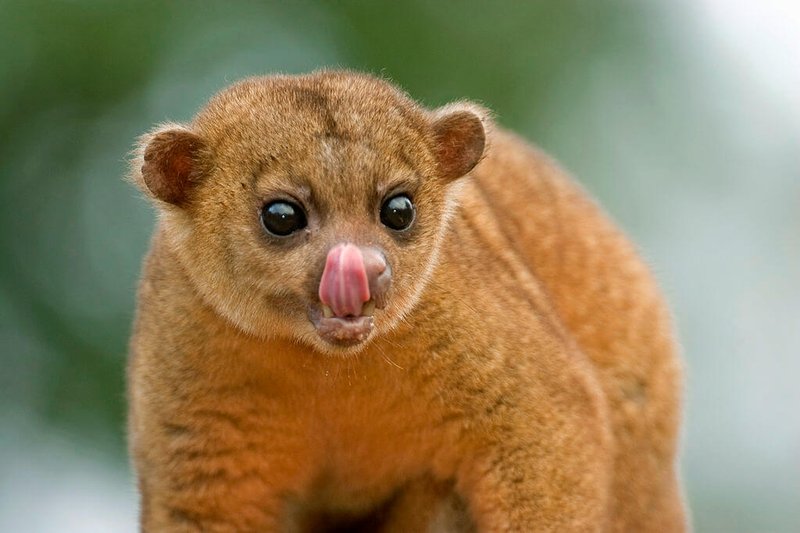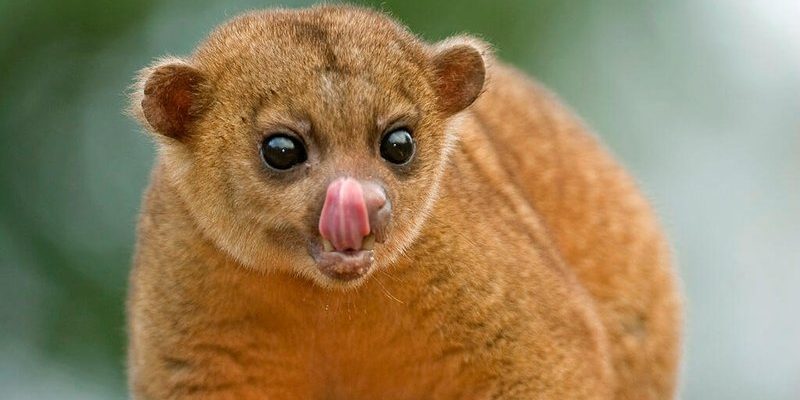
Imagine sitting in a cozy café, chatting with a friend about all the quirky creatures in the animal kingdom. You’d probably find it intriguing that the kinkajou, while distinct, shares its home and some traits with several other animals. Each of them brings something unique to the table, whether it’s a similar appearance, habitat, or behavior. So, let’s dive into the world of these fascinating creatures and see how they compare to the kinkajou.
1. Olingo
The olingo might just be the kinkajou’s closest relative. Both are part of the raccoon family and inhabit the same forested regions of Central and South America. Olingos are often mistaken for kinkajous due to their fluffy, tan or brown fur and large, expressive eyes.
One way to tell them apart is by their size. Olingos are generally smaller, weighing around 8-10 pounds, while kinkajous can tip the scales at up to 15 pounds. Another notable difference is in their tails: kinkajous have longer, more prehensile tails, which they use expertly for balance and grasping branches. So, if you see a little creature swinging through the trees, just check its size and tail for a quick ID!
2. Coati
Next up is the coati, a fun animal that’s often found in the same habitats as kinkajous. While coatis and kinkajous both enjoy the lush canopies of the tropical rainforest, they are quite different in appearance and behavior. Coatis have a longer snout and a more elongated body shape, resembling a small bear more than a kinkajou.
One key feature is the coati’s distinct striped tail that’s often held upright, which differs from the kinkajou’s tail that’s used more for climbing than display. You might also notice that coatis are diurnal, meaning they’re active during the day, while kinkajous prefer the cover of night. So, if you spot a stripey, snooping creature during daylight, it’s likely not a kinkajou!
3. Kinkajou (of course!)
Now, let’s take a moment to revisit the kinkajou itself. These charming little mammals are also known as “honey bears” because of their love for sweet treats like honey and fruit. Kinkajous are primarily nocturnal and are known for their playful, social behavior, often seen hanging out in groups.
One fascinating thing about kinkajous is their specially adapted tongue, which is incredibly long and helps them reach nectar and fruits deep within flowers. If you ever get the chance to watch one, you’ll see how agile they are, using their tails as an extra limb to navigate their treetop home. Honestly, they’re like little acrobats!
4. Lesser Mouse Lemur
If you’re peeking at nocturnal critters outside of the Americas, the lesser mouse lemur from Madagascar might catch your eye. They’re among the world’s smallest primates, making them quite different from kinkajous, but their big, round eyes and nocturnal habits draw the comparison.
One of the biggest differences is their size; these tiny lemurs weigh just about 2 ounces! They have a much more delicate build compared to the kinkajou, which is stockier and more robust. If you see a tiny, wide-eyed primate flitting around at night, it’s probably a lesser mouse lemur, and not a kinkajou.
5. Tamarins
Tamarins are another group of small primates that hold a special place in the rainforest. With their long, expressive mustaches and bright coloration, they certainly look different from kinkajous. These lively creatures often travel in groups and are known for their playful antics.
While kinkajous are more solitary and nocturnal, tamarins are diurnal and highly social. Their differences in behavior are quite striking! Additionally, tamarins tend to have more pronounced facial features, and you wouldn’t mistake their unique mustaches for the kinkajou’s smoother face. So, if you hear a lot of chattering during the day in the treetops, it’s likely a group of tamarins rather than kinkajous.
6. Slow Loris
Now let’s cross continents to Asia and meet the slow loris. These fascinating creatures share the kinkajou’s nocturnal lifestyle, but that’s where the similarities start to fade. Slow lorises are small, with a round face and large, expressive eyes. They have a more squat body shape and are known for their slow, deliberate movements.
The real kicker? Slow lorises are one of the few venomous mammals, using their toxins to defend against predators. In contrast, kinkajous are totally non-venomous and rely on their agility and climbing skills to stay safe. So if you’re watching a creature move slowly through the trees, take a closer look at its features—it might just be a slow loris.
7. Spotted Cuscus
Hailing from Australia and New Guinea, the spotted cuscus is another marsupial that may remind you of the kinkajou because of its arboreal lifestyle. With a round body and a bushy tail, their general shape does bear some resemblance. However, spotted cuscuses have a shorter tail and a thicker build.
What truly sets them apart is their fur. Cuscuses are often covered in spots and have a wider range of colors, from brown to gray, which makes them visually quite different from kinkajous. Also, like the kinkajou, they are herbivorous, but their diet mainly consists of leaves rather than fruits. If you spot one of these chunky marsupials in the trees, just remember its differences in fur and body shape!
8. Galago (Bush Baby)
Last, but certainly not least, the galago, also known as the bush baby, takes us back to the African continent. These small primates are known for their incredible jumping abilities and large, forward-facing eyes. Honestly, they look like they just jumped out of a cartoon with their big ears and expressive faces.
While both galagos and kinkajous are nocturnal, galagos are significantly smaller and more agile in their movements. Their distinctive, wide-set eyes help them see better in the dark, while kinkajous rely on their keen sense of smell. If you see something tiny and bouncing around in the trees, it’s probably a bush baby rather than a kinkajou!
In conclusion, the animal kingdom is full of fascinating creatures that bear similarities to the kinkajou, but each comes with its own unique traits and behaviors. By learning about these animals and how to tell them apart, you not only expand your knowledge but also deepen your appreciation for the diversity of wildlife around us. So next time you hear about these animals, you’ll be ready to wow your friends with your newfound insights!

